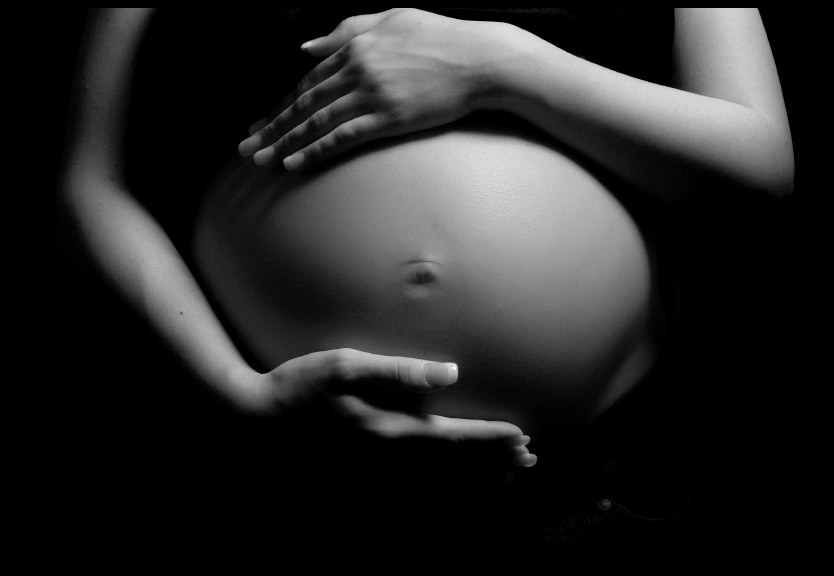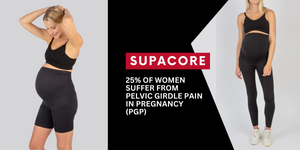
Introduction:
Supacore Coretech compression garments were developed based on scientific evidence and clinical experience to address common problems in pregnancy such as; pelvic girdle pain and injury, abdominal separation (Diastasis Rectus Abdominal Muscle DRAM) and lower back pain. There are many terms used to describe pelvic pain in pregnancy. These include peripartum pelvic pain, pregnancy-related pelvic pain, pregnancy-related pelvic girdle pain, anterior or posterior pelvic pain, and symphysis pubis dysfunction.1
The 2005 European guidelines describe PGP as pain between the posterior iliac crest and the gluteal fold, particularly in the vicinity of the sacroiliac joint, which may radiate to the thighs and hips. PGP can occur in conjunction with or separately to pain in the pubic symphysis. 2
Incidence:
Studies have shown that PGP is a relatively common problem in many countries, irrespective of their socio-economic status, with the incidence of pelvic pain in pregnancy reported as between 48–71%.4,3 The reported variation in incidence is due to the differing diagnostic criteria and the ambiguity in definitions.2 It is most probable that 20–25% of all pregnant women suffer from PGP that is serious enough to require medical intervention.5 PGP is not limited to a particular trimester of pregnancy as it is often experienced throughout pregnancy and postpartum; however, the onset most commonly occurs between 14 to 30 weeks’ gestation.2
Pathology:
According to the literature, many clinicians do not regard PGP as a serious complication of pregnancy, with an Australian study finding that only 25% of women who reported PGP were offered any form of treatment. 6 PGP is serious as it can interfere with many activities of daily living such us standing, walking, sitting, and all other activities in which the pelvis is involved. Moreover, it can even result in significant physical disability requiring the use of crutches or a wheelchair.6
The amount of pain experienced by women with PGP has corresponding psychosocial implications. These include extended leave from work during pregnancy, a reduction in the quality of life (as a result of being unable to carry out normal roles, affecting their ability to care for their children) and predisposition to chronic pain syndrome.6,7
The majority of women who experience PGP during pregnancy will recover spontaneously soon after delivery, however about 7% will report persistent PGP that may last for many years.8
The development of PGP in pregnancy is multifactorial and is related to hormonal, biomechanical, traumatic, metabolic, genetic and degenerative factors.9 While the hormone relaxin in pregnancy is often associated with joint laxity, there is no clear correlation between serum relaxin levels and peripheral joint laxity or PGP, indicating that the importance of hormonal influences in PGP iremains unclear.10
Women with PGP have increased pelvic, thoracic and lumbar joint mobility, resulting in pelvic instability and pain.11 Lumbopelvic muscle strength and coordination are reduced as a result of altered mechanical forces at the pelvic girdle.10

Diagnosis:
PGP in pregnancy is diagnosed after exclusion of other significant pathologies and/or obstetric complications (Table 1). 9, 5, 10 A detailed history and physical examination, including specific diagnostic tests will aid in the timely and accurate diagnosis of PGP. It is important to determine if the pain is mechanical in nature – that is, associated with activity and eases with rest – as pain that arises in the absence of mechanical stimuli is unlikely to be PGP.
Table 1. Differential diagnosis of pelvic girdle pain in pregnancy 5,10
|
Orthopaedic/musculoskeletal |
Obstetric and gynaecological |
|
|
|
Infection |
|
|
|
|
Vascular |
|
|
· Femoral deep vein thrombosis
|
Treatment:
A strategic approach should be implemented for activity modification, pelvic support garments, management of acute exacerbations, physiotherapy and exercise programs to prevent the progression of symptoms.5,11
Pelvic support garments can provide stabilisation at the pelvic girdle and reduce pain and severity of symptoms if fitted correctly and used for the appropriate periods of time.6
A systematic review of the available literature on the use of pregnancy support garments identified that wearing these garments during pregnancy could have beneficial effects such as; pain reduction (lower back pain, PGP), improvement of functionality and mobility, and reduction in the risk of falling during pregnancy.12
Supacore Coretech Compression Garments:
Supacore Coretech compression incorporate the compression provided by a pelvic belt into shorts and leggings that can be worn during sport, exercise and everyday activities. Pelvic support is provided by applying an external compressive force to the pelvis where it is needed and, in the direction, it is required. The compressive force mimics the body’s own deep internal stabilising system, in particular the transversus abdominus and the lumbo-sacral multifidus muscles.
The Supacore Coretech pregnancy garments have an elongated waist which replicate the action of abdominal binders, such as TubigripTM and elasticised abdominal braces.
References:
- Howell ER. Pregnancy-related symphysis pubis dysfunction management and postpartum rehabilitation: two case reports. J Can Chiropr Assoc. 2012 Jun;56(2):102-11. PMID: 22675223; PMCID: PMC3364059.
- Walters C, West S, Nippita TA. Pelvic girdle pain in pregnancy. J RACGP. 2018 July;47(7) doi: 10.31128/AJGP-01-18-4467
- Depledge J, McNair PJ, Keal-Smith C, Williams M. Management of symphysis pubis dysfunction during pregnancy using exercise and pelvic support belts. Physical Therapy. 2005;85(12):1290–1300. [PubMed] [Google Scholar] [Ref list]
- Stuge B. Pelvic girdle pain: examination, treatment, and the development and implementation of the European guidelines. J Ass Physio Womens Health. 2012 Autumn; 111: 5-12.
- Vleeming A, Albert HB, Östgaard HC, Sturesson B, Stuge B. European guidelines for the diagnosis and treatment of pelvic girdle pain. Eur Spine J 2008;17(6):794–819. doi: 10.1007/s00586-008-0602-4.
- Pierce H, Homer CSE, Dahlen HG, King J. Pregnancy-related lumbopelvic pain: Listening to Australian women. Nurs Res Pract 2012;2012:387428. doi: 10.1155/2012/387428.
- Mackenzie J, Murray E, Lusher J. Women’s experiences of pregnancy related pelvic girdle pain: A systematic review. Midwifery 2018;56:102–11. doi: 10.1016/j.midw.2017.10.011.
- Wu WH, Meijer OG, Uegaki K, Mens JM, van Dieën JH, Wuisman PI, Ostgaard HC. Pregnancy-related pelvic girdle pain (PPP), I: Terminology, clinical presentation, and prevalence. Eur Spine J. 2004 Nov;13(7):575-89. doi: 10.1007/s00586-003-0615-y. Epub 2004 Aug 27. PMID: 15338362; PMCID: PMC3476662.
- Homer C, Oats J. Clinical practice guidelines: Pregnancy care. Canberra: Australian Government Department of Health, 2018; p. 355–57.
- Bhardwaj A, Nagandla K. Musculoskeletal symptoms and orthopaedic complications in pregnancy: Pathophysiology, diagnostic approaches and modern management. Postgrad Med J 2014;90(1066):450–60. doi: 10.1136/postgradmedj-2013-132377
- Wu WH, Meijer OG, Bruijn SM, et al. Gait in pregnancy-related pelvic girdle pain: Amplitudes, timing, and coordination of horizontal trunk rotations. Eur Spine J 2008;17(9):1160–69. doi: 10.1007/s00586-008-0703-0.
- Carolina Quintero Rodriguez, Olga Troynikov, "The Effect of Maternity Support Garments on Alleviation of Pains and Discomforts during Pregnancy: A Systematic Review", Journal of Pregnancy, vol. 2019, Article ID 2163790, 21 pages, 2019. https://doi.org/10.1155/2019/2163790

